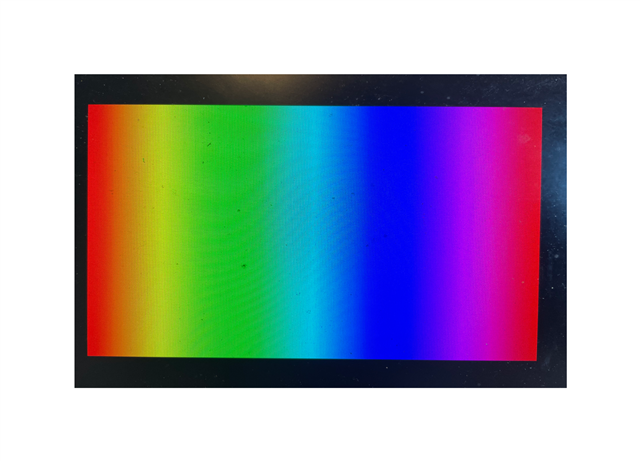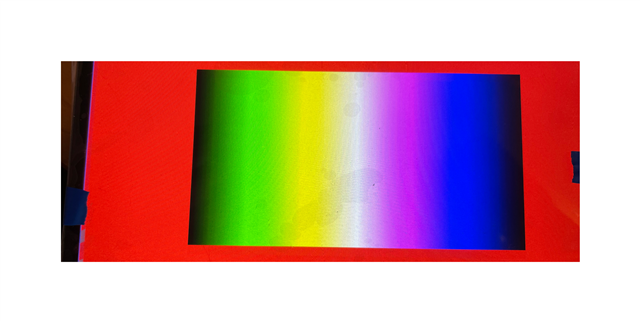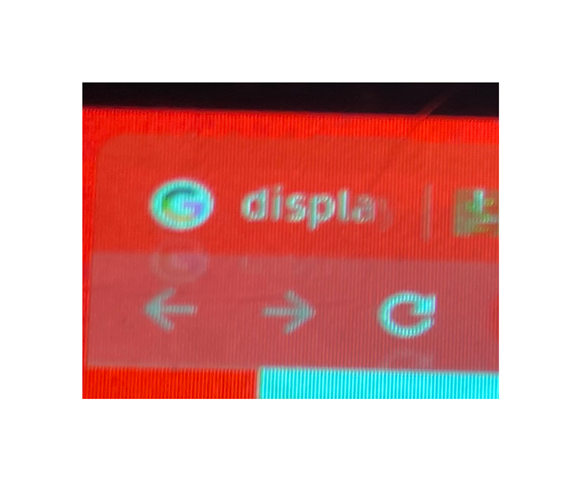Other Parts Discussed in Thread: TFP401
Hello,
We have just designed a board using a TFP401A to decode an HDMI signal into a 24 bit parellel RGB signal that is then sent to a standard 50-pin TFT display module which uses a 24-bit parallel RGB bus. After configuring an EDID with the correct resolution, the image shows up with the correct resolution but the completely wrong colors. We've tried a couple of different things and have double checked the pin-out but have been unable to root cause the issue so far.
Link to to images and schematic
Here's a summary of what we've done:
TFP401 Configuration:
See attached schematic page for more info.
DFO: set to TFT (low)
ST: set to high (33 ohm external resistor in series with each RGB line)
PIXS: set to 1px/clk mode (low)
STAG: set to high (unstaggered)
OCK_INV: set to falling edge (low)
Images:
Image 1: Correct colors:

Image 2: Colors shown on display

Image 3: "Ghosting" issue. Note that the ghost image is not actually burned in and moves with the window on the display.

Observations/Issue Description:
1. Red and Black appear inverted. This is odd as it does not seem like a simple R/B or R/G swap.
2. Image shows some "ghosting" that tracks the image on the display. It looks like two frames are overlapping each other with one frame being vertically offset from the other.
3. HSYNC and VSYNC signals are generated at ~38Khz and ~60hz as expected for display resolution with no obvious Jitter
4. Clock shows up at expected 51Mhz frequency.
Solutions Attempted:
1. Tested a different TFT panel. Same issue occurs
2. Tested the TFT panel with the board supplied by the manufacturer. This worked as expected and had no color issues. Their implementation used an LT8619C from Lontium semiconductor to perform the decoding.
3. Checked all the bias voltages and made sure they matched the manufacturer demo board.
4. Tried changing clock edge from high to low. This resulted in a worse image showing up with the same color issue.
5. Tried changing from TFT mode to DSTN mode. This offset the image on the display but did not fix any issues.
6. Change the EDID color space from 8-bit RGB to Y'CbCr 4:4:4 or other color-spaces. This shifted the colors that showed up on the display but did not actually resolve the issue.
7. Change the EDID frame rate from 60hz to 30hz. This appeared to do nothing
Schematic PDF:
UPDATE
Turns out the color issue was caused by the red channel being inverted. This was caused by a swapped D2 pair coming from the HDMI line. After swapping this pair the color issue went away but I am still seeing the second "Ghosting". Any clue on what could be causing this issue? I will post more pictures later.
If anyone has any ideas on what could be wrong help would be greatly appreciated!

